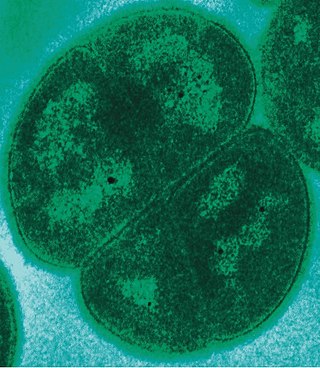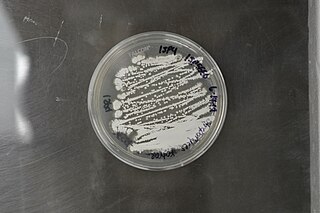Related Research Articles

Genus is a taxonomic rank above species and below family as used in the biological classification of living and fossil organisms as well as viruses. In binomial nomenclature, the genus name forms the first part of the binomial species name for each species within the genus.

Deinococcota is a phylum of bacteria with a single class, Deinococci, that are highly resistant to environmental hazards, also known as extremophiles. These bacteria have thick cell walls that give them gram-positive stains, but they include a second membrane and so are closer in structure to those of gram-negative bacteria.
Mollicutes is a class of bacteria distinguished by the absence of a cell wall. The word "Mollicutes" is derived from the Latin mollis, and cutis. Individuals are very small, typically only 0.2–0.3 μm in size and have a very small genome size. They vary in form, although most have sterols that make the cell membrane somewhat more rigid. Many are able to move about through gliding, but members of the genus Spiroplasma are helical and move by twisting. The best-known genus in the Mollicutes is Mycoplasma. Colonies show the typical "fried-egg" appearance.
The Thermotogota are a phylum of the domain Bacteria. The phylum contains a single class, Thermotogae. The phylum Thermotogota is composed of Gram-negative staining, anaerobic, and mostly thermophilic and hyperthermophilic bacteria. It is the sole phylum in the kingdom Thermotogati.

The Jimmye Laycock Football Center (JLFC) is a football facility for The College of William & Mary Tribe in Williamsburg, Virginia, USA. The $11 million, 30,000-square-foot (2,800 m2) building was constructed right next to Zable Stadium where the Tribe play all home games. The facility is named after William & Mary's most successful football coach Jimmye Laycock, and the cost of the project was funded entirely through private donations.
Arcobacter is a genus of Gram-negative, spiral-shaped bacteria in the phylum Campylobacterota. It shows an unusually wide range of habitats, and some species can be human and animal pathogens. Species of the genus Arcobacter are found in both animal and environmental sources, making it unique among the Campylobacterota. This genus currently consists of five species: A. butzleri, A. cryaerophilus, A. skirrowii, A. nitrofigilis, and A. sulfidicus, although several other potential novel species have recently been described from varying environments. Three of these five known species are pathogenic. Members of this genus were first isolated in 1977 from aborted bovine fetuses. They are aerotolerant, Campylobacter-like organisms, previously classified as Campylobacter. The genus Arcobacter, in fact, was created as recently as 1992. Although they are similar to this other genus, Arcobacter species can grow at lower temperatures than Campylobacter, as well as in the air, which Campylobacter cannot.
Polynucleobacter cosmopolitanus is an aerobic, catalase- and oxidase-positive, chemo-organotrophic, nonmotile bacterium of the genus Polynucleobacter, isolated from freshwater habitats in Eurasia, South America, North America, Africa, Oceania, the Hawaiian Archipelago, in lakes located in Japan, and a river estuary of northern Taiwan. The type strain of the species was isolated from Lake Mondsee in Austria.
Polynucleobacter difficilis is an aerobic, catalase- and oxidase-positive, chemo-organotrophic, nonmotile, freshwater bacterium of the genus Polynucleobacter, isolated from the Lake Sevan from a depth of 60 m in Armenia.
Polynucleobacter rarus is an aerobic, chemo-organotrophic, catalase- and oxidase-positive, nonmotile bacterium of the genus Polynucleobacter, isolated from an acidic lake in Wisconsin.
Thermothrix azorensis is a Gram-negative, facultatively chemolithoautotrophic, non-spore-forming, aerobic, thermophilic, sulfur-oxidizing bacterium of the genus Thermothrix, isolated from a hot spring on Sao Miguel Island in the Azores. T. azorensis uses thiosulfate, tetrathionate, hydrogen sulfide, and elemental sulfur for its sources of energy (chemolithoautotrophic).
Thermothrix thiopara is a Gram-negative, facultatively chemolithoautotrophic, thermophilic, motile bacterium with a single polar flagellum of the genus Thermothrix, isolated from a hot sulfur spring.
Bordetella petrii is a bacterium of the genus Bordetella isolated from different habitats, including humans. B. petrii has the ability to grow under aerobic conditions and adapt to different environmental conditions. The complete genome of B. petrii has been sequenced.
Entomoplasma is a mollicute bacteria genus. Entomoplasma freundtii can be isolated from the green tiger beetle.
Mesoplasma is a genus of bacteria belonging to the class Mollicutes. Mesoplasma is related to the genus Mycoplasma but differ in several respects.

Streptomyces caniferus is a bacterium species from the genus of Streptomyces.

Streptomyces katrae is a bacterium species from the genus of Streptomyces which has been isolated from soil in India.
Streptomyces spiralis is a bacterium species from the genus of Streptomyces which has been isolated from soil in Brazil.
Hydrogenobacter is a genus of bacteria, one of the few in the phylum Aquificota. Type species is H. thermophilus. This genus belongs to Bacteria as opposed to the other inhabitants of extreme environments, the Archaea.
Fodinibacter is a genus of Gram positive, nonmotile, non-sporeforming bacteria. The bacteria are strictly aerobic and mesophilic. Cells of the genus are irregular rods and grow very poorly in the absence of NaCl. The genus name is derived from the Latin fodina (mine), referring to the salt mine from which the type of species was isolated.
Humibacillus xanthopallidus is a species of Gram positive, nonmotile, non-sporeforming bacteria. The bacteria are strictly aerobic and mesophilic. Cells of the genus are irregular rods. Humibacillus xanthopallidus, was originally isolated from both a paddy field in Saitama Prefecture, Japan and from a sediment collected from Lake Jusanko, Aomori Prefecture, Japan.
References
- ↑ bacterio.net Archived 2013-09-22 at the Wayback Machine
- ↑ bacterio.net Archived 2013-09-22 at the Wayback Machine
- ↑ Genus VIII Thermothrix Caldwell, Caldwell and Laycock 1981, 217 (Effecktive publication: Caldwell, Caldwell and Laycock 1976 1515)